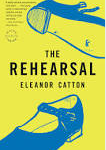 Eleanor Catton’s debut novel “The Rehearsal” opens with a teacher of the saxophone explaining why she takes only experienced musicians as students, and that the aspiring player before her is just too young. Why the saxophone? In Ms. Catton’s hands its smooth gold curves suggest sexual and emotional vulnerability. Which makes sense, since “The Rehearsal” is a coming of age novel centered around the fallout from an affair between a female student and an older, male teacher. The story is told to the saxophone teacher during lessons.
Eleanor Catton’s debut novel “The Rehearsal” opens with a teacher of the saxophone explaining why she takes only experienced musicians as students, and that the aspiring player before her is just too young. Why the saxophone? In Ms. Catton’s hands its smooth gold curves suggest sexual and emotional vulnerability. Which makes sense, since “The Rehearsal” is a coming of age novel centered around the fallout from an affair between a female student and an older, male teacher. The story is told to the saxophone teacher during lessons.
Victoria, about 18, and her younger sister Isolde are both students at Abbey Grange, a girls school; Victoria is in her final year. Victoria had (and may be continuing) the affair, and the rest of the girls in her form, along with Isolde, are required to attend a series of counseling sessions. It’s a ham-handed adult response, and the girls, particularly one named Julia, undermine its intent reasonably effectively while also absorbing the lesson that sex is something they can continue to look forward to. Isolde feels quite out of place among the older girls and doubly singled out as the sister of the violated girl. Perhaps she’s more at risk, as the school authorities feel. Isolde just feels annoyed.
The saxophone teacher’s studio is located off campus. While the girls’ story is unfolding, in another part of the building a group of acting hopefuls is auditioning for admission to the Drama Institute. That action centers on Stanley, the child of a single mother whose father lives on another continent. We never see Stanley’s mother, but his father drops in once a year to give Stanley dinner and advice. Stanley is admitted to the Institute, and during the course of his first year he learns a great deal – perhaps more than he expects – about acting. He also befriends Isolde, who stumbles into a backstage area on her way to a sax lesson.
The stories come together when the first year acting class, completing its assignment to develop and perform an original work of theater, build on the news story of the local girl who’s been molested. To them, it’s just news, and they don’t think much about the real people who might be behind it. Those people, of course, are the girls who talk to the saxophone teacher (she is never named). But are they? There are hints that those conversations may be taking place on a stage, perhaps as background as the show develops, perhaps in performance.
Catton’s point, or one of them, is that we perform roles every day, and sometimes it can be quite hard to tell what is ‘real’ and what is not. The work of teenagers is to try on and reject roles, and Catton describes the inner lives of her adolescent characters quite convincingly. It’s a fascinating book, and leaves the reader full of restless, resonant questions. Sometimes they seem to resolve one way, sometimes another, and the ambiguity is surprisingly satisfying.
Have a book you want me to know about? Email me at asbowie@gmail.com. I also blog about metrics at asbowie.blogspot.com.


